North Country Honor Flight #67 flies to Washington D.C.
Plattsburgh – North Country Honor Flights #66 and #67 took to the skies on Saturday, October 4, 2025. Dave Brown took photos of the Send-Off Ceremony and allowed the Peru Gazette to post them. Thank you! Dave. Gina Bond provided the veteran biographies. The following veterans flew on Flight #67.
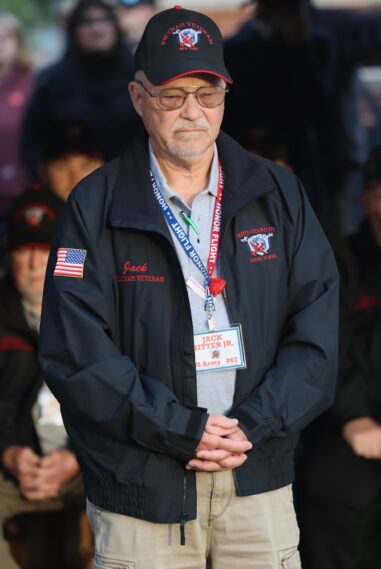 Jack Bitter Jr., US Army, 1968-1970, Vietnam
Jack Bitter Jr., US Army, 1968-1970, Vietnam
Upon receiving orders to Tan Son Nhut, Vietnam, Jack would arrive at temperatures of 80 degrees Fahrenheit in his Class-A issued green wool uniform. His one-year deployment to Vietnam would be served as a Combat Engineer Unit Commander, with assignments in the concrete, quarry stone, and asphalt divisions. Initially, he was assigned to the 46th Engineer Battalion, followed by reassignment to the 103rd Engineering Company in Bien Hoa. His final tour assignment would involve the 34th Engineers asphalt division, responsible for paving roads. Regular morning mine sweeps were conducted, as these roads would facilitate access all the way to the Michelin Rubber Plantations.
In recognition of his service, Jack would be awarded many commendations some include the Bronze Star Medal, two overseas service bars, the Vietnam Campaign Medal, the Vietnam Service Medal, and the Expert Badge with Rifle Bar.
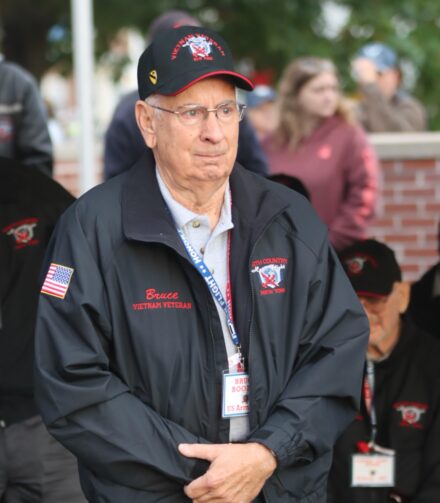 Bruce Boozan, US Army, 1968-1969, Vietnam
Bruce Boozan, US Army, 1968-1969, Vietnam
Drafted and sent to Vietnam, along the way his plane would make emergency landings in Alaska and Japan. On his first day, Bruce was delivered to the 1st Cav base camp in An Khe by chopper. Special Forces selected him and another soldier to fly to the Ho Chi Minh Trail in Laos, dropped near 200 NVA. A B52 strike called in; they returned to camp the next morning. First as a rifleman and point man, Bruce became a radio operator when their radioman was hit. Facing firefights near Quon Loi, and limited fire support in Cambodia, he would be injured while in the dense jungle. Evacuated to a Japanese hospital, he expected to return to Vietnam but at the last minute would receive assigned to South Korea.
Bruce earned many decorations, but his Combat Infantry Badge means the most. He still sleeps with one eye and ear open.
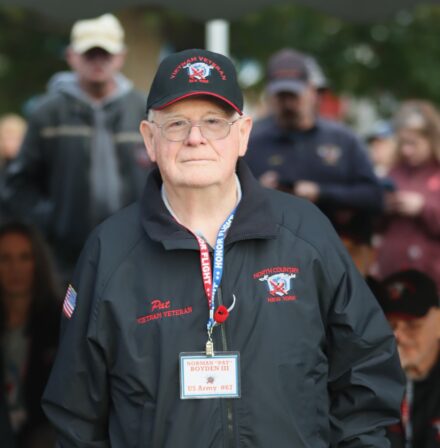 Norman “Pat” Boyden III, US Army, 1967-1973, Vietnam
Norman “Pat” Boyden III, US Army, 1967-1973, Vietnam
Pat would be commissioned at UVM ROTC as a Second Lieutenant, graduating from Infantry Officer Basic and Ranger School before serving in West Berlin, Germany. He would be ordered to the 1st Battalion, 2nd Infantry, and 1st Infantry Divisions as commander for 4 months and Bravo Company for 4 months. He would be reassigned to 1st Battalion, 7th Cavalry, and 1st Cavalry Divisions as S-1, Personnel Officer. On a flight to Division Headquarters seeking replacements after high casualties, his helicopter would crash, hospitalizing Pat for a month, before returning him stateside. Reporting to duty as a student at the Infantry Officer Advanced Course at Fort Benning, his final assignment would assign him to Fort Hood, 2nd Armored Division, for six and a half years. Here he would retire as a Captain, and Headquarters Commandant of the 2nd Armored Division.
Pat has served as Veterans Chaplain in the Disabled American Veterans, the Vietnam Veterans of America, the Vermont State Guard, and the Families of Vermont Fallen for over 30 years.
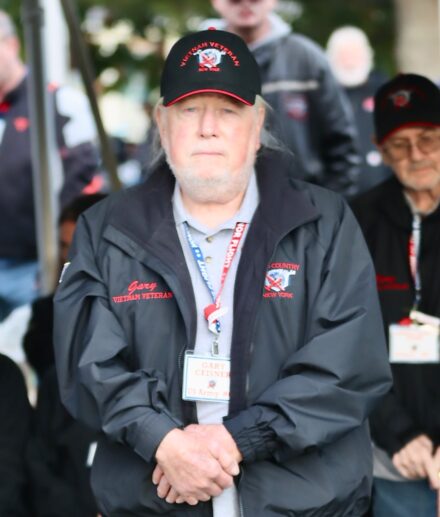 Gary Ceisner, US Army, 1965-1967, Vietnam
Gary Ceisner, US Army, 1965-1967, Vietnam
Gary would be drafted after graduating from college. Before deployment to Vietnam, he would train in light weapons infantry, as a fire team leader, and as an assistance drill sergeant. Assigned to the 196th, at Tay Ninh Providence in war zone C. As part of the helicopter assault unit, he would participate in some major combat operations and smaller search and destroy missions. Gary would be injured in a chopper bailout while under fire. Returning to action, Gary would be reassigned to the 5th mechanized infantry division in Cu Chi, with missions in Ho-Bo Woods, Iron Triangle, and Parrots Beak areas. As fire team leader, he’d reinjure his knee, receive care in Saigon. This injury would return him stateside where he would reunite with his now-wife Linda of 58 years. A 1966 Christmas cease-fire, a visit and gift from chopper Santa, and a hot meal, would be a good day.
Gary learned that in tough situations, it’s crucial to trust great people. Your friends will make grand gestures. Follow good advice when given. While bad politics can lead to bad wars, immense pride is derived from service to country, even in the most challenging of times.
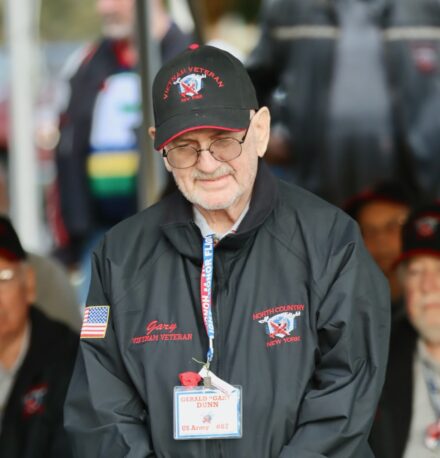 Gerald “Gary” Dunn, US Army , 1969-1970, Vietnam
Gerald “Gary” Dunn, US Army , 1969-1970, Vietnam
After one year of college, Gary would join the Army. After receiving his infantry training, he would serve 11 months in Germany. Soldiers were told to use care when traveling during that time as Germany was experiencing significant social upheaval. Serving the next 14 months in the Chu Lai area of Vietnam, Gary would continue his assignment in supply. Here, he would be responsible for ordering everything from toilet paper to helicopters. He said there was a 2-sheet max on toilet paper, but nobody was counting. During his deployment, he would meet up with a cousin who was just two miles away. Their homes stateside were also only two miles apart. Gary recalls little sleep. A ten-night stretch would have 30 helicopters drawing fire from enemy camp; the noise was intense. On December 15, 1969, four of his buddies from his unit would leave on a mission by helicopter and not return. He will pay his respects to all of them on his journey today.
Gary would receive many decorations from his service, including the Army Commendation Medal for meritorious service in the Republic of Vietnam.
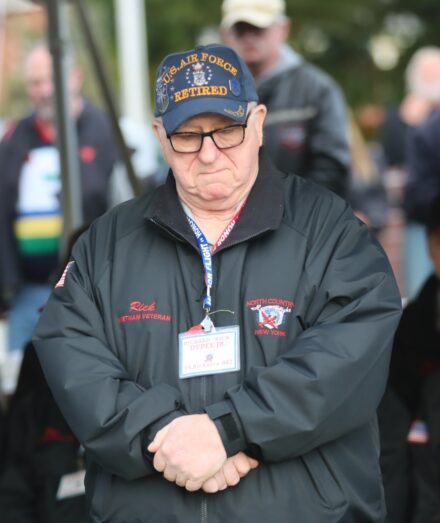 Richard “Rick” Dupee Jr., US Air Force, 1972-1992, Vietnam, Cold War
Richard “Rick” Dupee Jr., US Air Force, 1972-1992, Vietnam, Cold War
Rick started his security police service in Fairbanks, Alaska. Guarding aircraft, he saw an engine fall from a C-5 during landing. In a priority area with nuclear weapons a man would jump the low fence and walk cross the runway. Rick shouted, “Halt! Halt! Halt!” Within 100 feet, he could’ve shot the drunk civilian seeking gas. It ended with him on the taxiway in freezing temperatures. Blindness in one eye led Rick to be reassigned as a clerk, followed by Officer Club Steward. Although he won awards as Steward the long hours and time away from family prompted another transition. Now a trainer at Offutt AFB, Rick automated the training process, increasing productivity from 500 up to 1600. General Swartz would give him one direct order: “Don’t tell anyone how you do your work until you leave.” Rick frequently traveled stateside for TDY. Six days before his scheduled deployment to Vietnam, his orders were canceled due to downsizing. He never expected a 4-year commitment to become a career, but he excelled at everything he tried. Regrettably, he never finished his degree to become an officer.
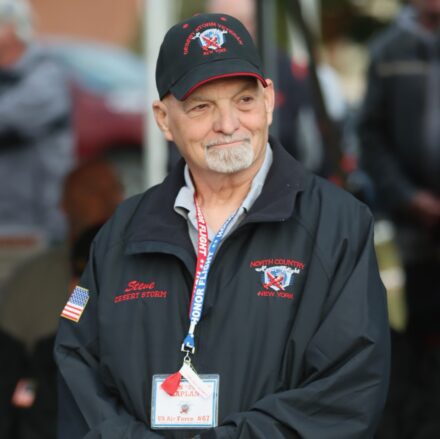 Steven Kaplan, US Air Force, 1978-2004, Cold War, Desert Storm
Steven Kaplan, US Air Force, 1978-2004, Cold War, Desert Storm
Following in his father’s footsteps, Steve would make a career from Air Force service. With a direct duty assignment in Ellsworth, South Dakota, Steve would receive training in heavy equipment and join the 44th Civil Engineering Squadron. Stationed in Plattsburgh, he would serve 13 years in Civil Engineering until making a switch to aircraft maintenance, which allowed him to work on FB 111s and the KC 135s. He would complete a 2-month training at Chanute AFB in hydraulics and would be relocated to Little Rock, Arkansas, where he retired after 26 years of service. Steve would complete multiple leadership trainings that would impact his service career, as well as receiving numerous commendations, recognition, and promotions. The most challenging part of his service career was the time spent away from his family. To this day, Steve continues to work, now as a civilian, with the airmen at the Little Rock base that houses a fleet of 130 planes.
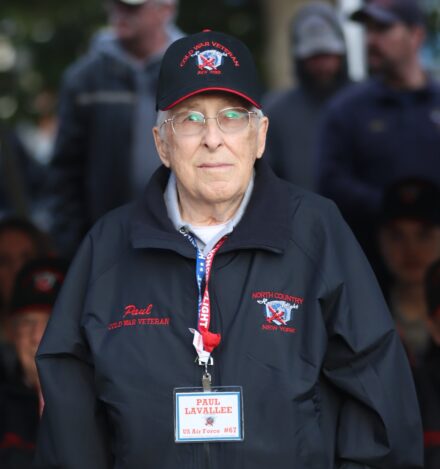 Paul Lavallee, US Air Force, 1957-1961, Cold War
Paul Lavallee, US Air Force, 1957-1961, Cold War
Paul would receive a high score in Morse code. With a greater interest in electronics, opted for repair. He would receive training in airborne electronics radio and radar. At Scott AFB he completed his specialized training over the next 9 months. Stranded in Alaska for 10 days, Paul would only have his one set of clothes. With no tow ropes, they would work in the dark to fix engine problems under a tarp. Experiencing trouble to get the O-ring in place, this multi-million-dollar plane would be repaired with spit and cold temperatures. A TDY to Trinidad for 3 months would place Paul at the operations control tower for sea landings. They would receive a call and head back to the tower when needed. A Naval captain would inquire exactly what was going on and where were the tower crew. Due to high levels of enlistment, the Air Force wanted 9 months’ notice for reenlistment. Promotion and making rank were difficult at the time, so Paul would decide to exit at the end of his 4-year commitment.
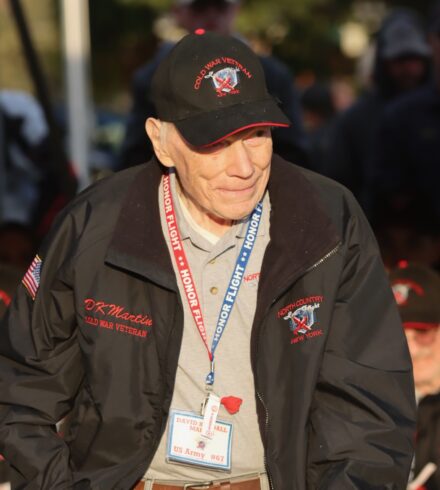 David Kendall Martin, US Army Signal Corp, 1955-1957, Cold War
David Kendall Martin, US Army Signal Corp, 1955-1957, Cold War
David knew that a universal draft meant military service, so he chose to join voluntarily. He viewed his service as necessary, and it would later allow him to concentrate on his two passions, marriage and teaching. After ROTC training and graduating from Union College, David completed basic training at Fort Jackson. He then moved to Fort Monmouth in New Jersey and stayed on to teach basic electronics. While in the service, David would marry his high school sweetheart. He knew the first time he saw her on the dance floor that she was the one for him. He would opt out of travel opportunities to happily teach and take the train home to his wife each weekend. Under the watchful eye of a neighbor, this military-clad gentleman showing up at the door every weekend was scandalous.
After completing his active duty, David would return home and was to serve the remainder of his service on reserve duty. He would be assigned to the Presidential Honor Guard, but he would never see the President or stand as honor guard.
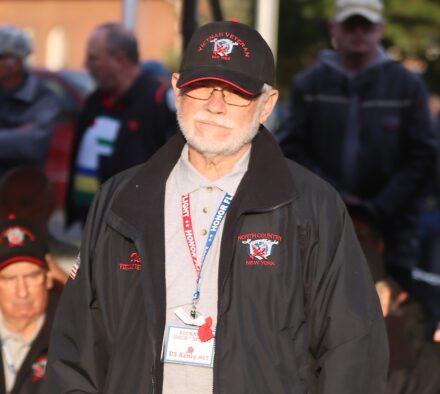 Richard “Dick” Musto, US Army, 1970-1972, Vietnam
Richard “Dick” Musto, US Army, 1970-1972, Vietnam
Drafted into the military out of college, Dick would head to Fort Dix for basic training. Transferred to Monmouth Army Base, he would receive his advanced training as a Crypto Mechanic. There he would be assigned to the Army Security Agency of the Signal Corps.In May of 1971, Dick would be shipped to Germany. His first assignment was to the Herzo base. His top-secret clearance had not arrived, so he would be temporarily assigned as a post gardener. He didn’t mind this assignment; he got to dress casually in shorts to tend to the gardens. In September his clearance would finally arrive, and he would begin his work in communications. Two weeks later, he would be transferred to Army Base 25 kilometers from Nuremberg, by the Czechoslovakian border. In this assignment, he would spend the majority of his time monitoring Czech and Russian radio broadcast communications. During his time in Germany, he would be fortunate to twice attend the Oktoberfest in Munich.
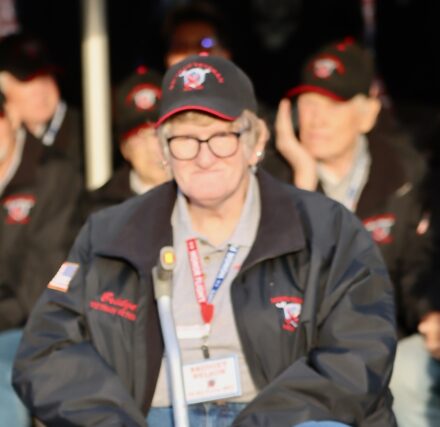 Bridget Nelson, US Air Force, 1974-1985, Vietnam, Cold War
Bridget Nelson, US Air Force, 1974-1985, Vietnam, Cold War
Looking for a challenge after two years of college, Bridget would enlist. After training at Sheppard, she would be assigned to Brooks, serving as an Aerospace Physiologist for five years. In this position she would train aircrews to handle extreme G-forces and dangerous altitudes. She’d also explore the effects of fatigue, stress, and other human limitations through real-life training.Bridget, would return to the classroom at Sheppard for a second career training in cost and management analysis. Assigned to Plattsburgh, Bridget planned, organized, and evaluated key decisions supporting base operations. After 11 years of service, Bridget would exit the military. Regardless of all her assigned responsibilities one of the more stressful moments would be to deliver a 30-minute speech.
Bridget would complete her bachelor’s degree in computer science after exiting the military with the assistance of the GI bill. She was honored to serve her country and is thankful for the opportunities that resulted from her service.
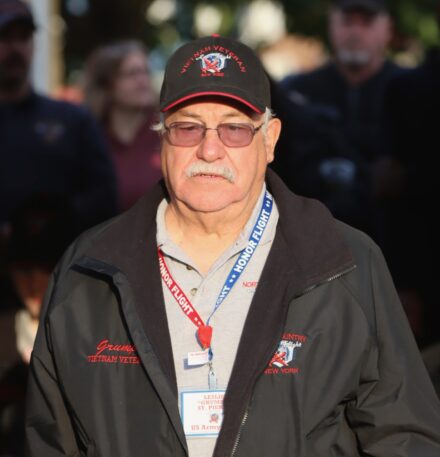 Leslie “Grumpy” St. Pierre, US Army, 1969-1971, Vietnam
Leslie “Grumpy” St. Pierre, US Army, 1969-1971, Vietnam
Exiting college, Les would make the decision to join the Army. On the bus to boot camp, the bus driver would holler over to him; it would turn out to be one of his best friends from home. Les would be sent to Fort Hood to train as a mechanic. While there, he would be sent to typing school and would end up serving 11 months in a supply clerk position. Ready to be deployed to Vietnam, the Army would offer him helicopter flight school. Accepting this would have kept him stateside for an undetermined time. He would opt out of training and commit to his orders for Vietnam. Arriving in country, he would join the main support battalion in Long Binh in southern Vietnam, along the DMZ. By the end of his year-long tour his battalion would head into Laos. Les would take advantage of the opportunity to make a trip as a door gunner to Da Nang, hoping to meet up with his cousin, but he had already left to return to stateside.
In reflection, Les recalls moments and memories as a young service member. An explosion of an ammo dump sent him to the floor. Having a vision of Texas and its history as a young boy, he was happy that he got to see it while in the service. His pride in serving his country, but disappointment in the support for veterans returning home.
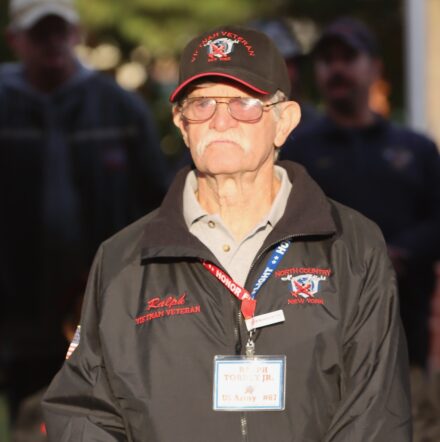 Ralph Torrey Jr., US Army, 1968-1971, Vietnam
Ralph Torrey Jr., US Army, 1968-1971, Vietnam
Ralph’s respect and admiration of his father’s heroic and dedicated service career would guide him. Reporting to Fort Eustis, he would complete US Transportation Helicopter School. Deployed to Long Binh, he would join the 120th Aviation Company. Supporting ground troops with evacuations, they would be shot up by heavy fire, causing an electrical fire. On another late afternoon mission, flying through an open section with tree lines on both sides. Caught in the crossfire, the helicopter would catch fire. Ralph as the door gunner, at 400 yards from the fire point, would jump out as they hovered 3 feet from ground, extinguished the fire, jump back aboard. Ralph would receive the Air Medal for Valor when his best friend and he jumped on an unscheduled mission. Damage to the helicopter would bring them down. Under fire, leaning forward saved them from bullet holes that passed through the chopper cabin above their heads. Lt. Colonel took them off flight status despite their desire to return to action. Their regular patrol was 9 p.m. to 4 a.m. Taking off from Tan Son Nhut, the tail rotor would fail on take-off. Thankfully, an experienced pilot was on board landing them safely. Unfortunately, they had a first-time gunner aboard. Ralph would serve 27 months in country, ending his tour with 2,000 Vietnam helicopter hours, and many commendations. His accompanied by is son today, a 21-year Air Force veteran.
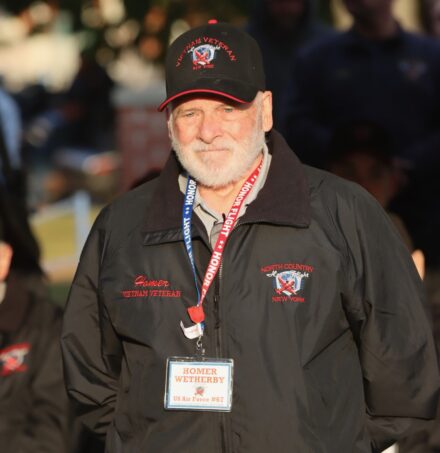 Homer Wetherby, US Air Force, 1968-1988, Vietnam, Cold War
Homer Wetherby, US Air Force, 1968-1988, Vietnam, Cold War
Looking for a direction in life, Homer would join the service. Hoping for an assignment as security police or weather specialist, he would be sent to Sheppard for medical training. Transferred to Blytheville AFB, he would work in their hospital for 18 months. Then to Thailand for 12 months in the combat support hospital for air vacs.
Receiving a humanitarian placement for 4 years to Plattsburgh allowed Homer to come home weekends to care for both of his ailing parents. His next assignment would take him to the Azores in Portugal, to work in a multi-service branch hospital.
At Gunter AFB, Homer would branch off into administration of hospital computerized systems. Traveling a lot, he would train other facilities on integration of computer systems. Training an 80-year-old, his best student, when she was certain that no one “can teach me this stuff” would give him immense job satisfaction.
He would serve 4 more years at Loring before retiring. In Homer’s twenty years of service, he cultivated a valuable career set, making it possible for him to make rank and grow in his field.
Posted: October 13th, 2025 under Adirondack Region News, City News, Community Events, General News, Honor Flights, National News, Northern NY News, Peru/Regional History, Regional NY-VT News, Veterans' News.
